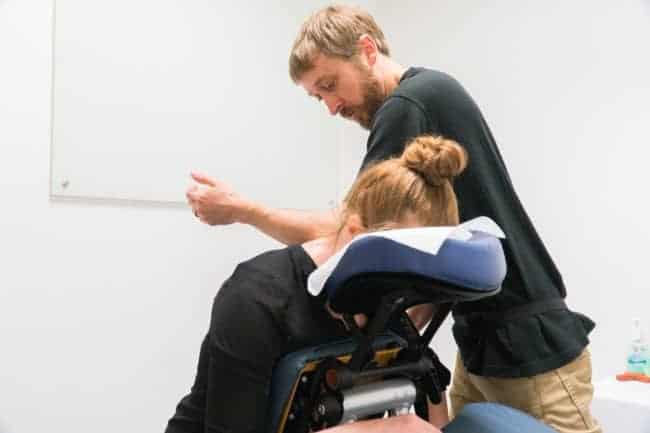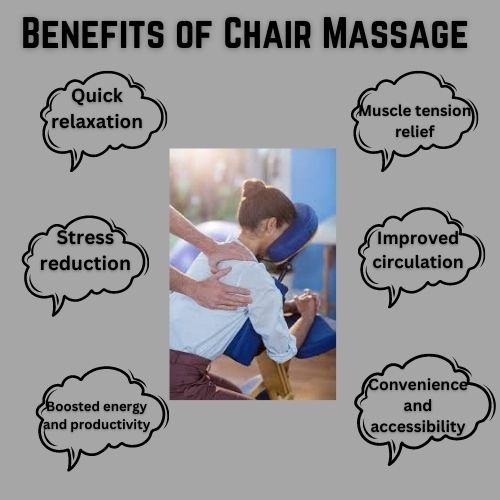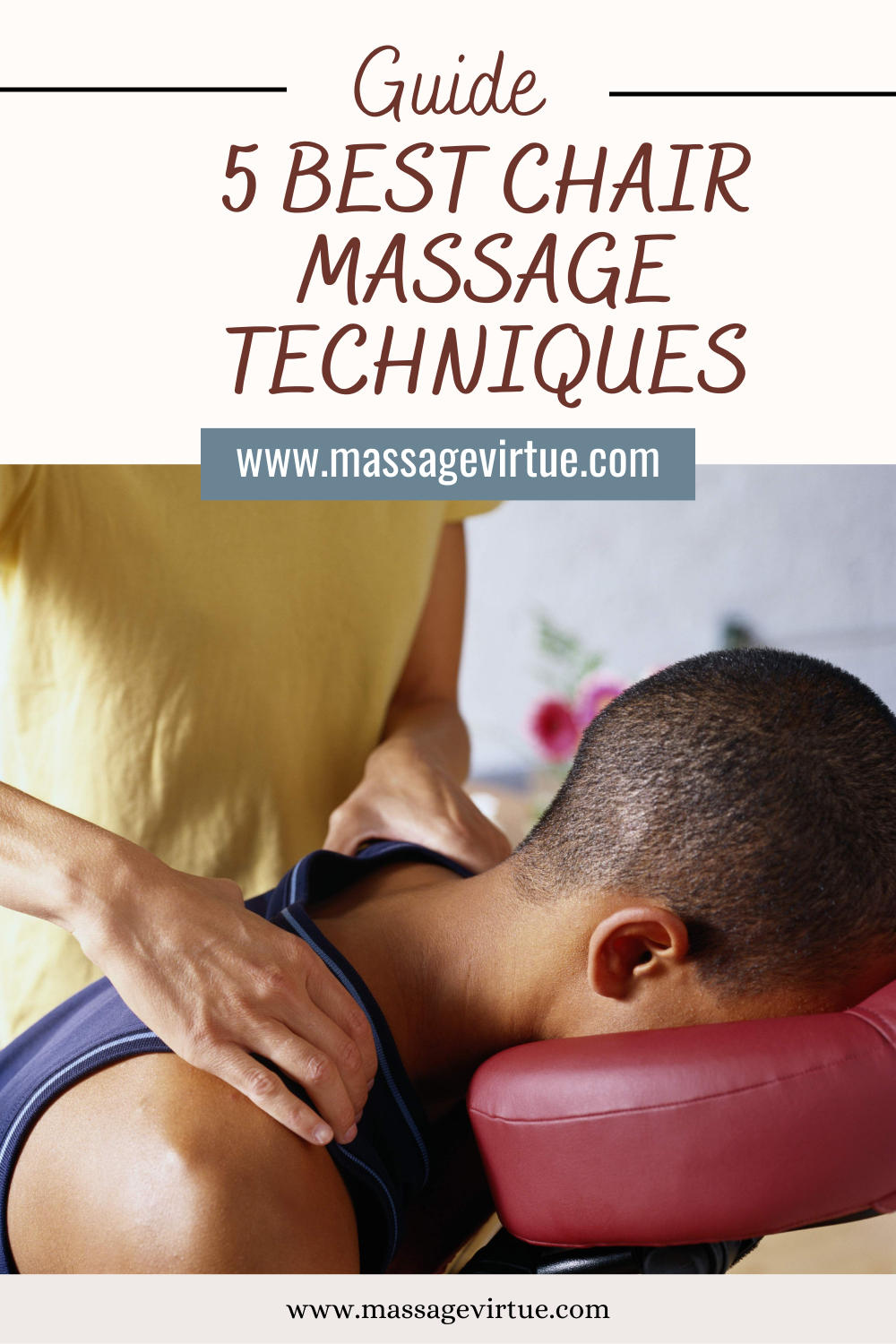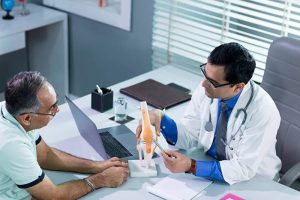Are you looking to explore the best chair massage techniques for ultimate relaxation? You’ve come to the right place!
Chair massage offers a practical and accessible way to unwind, melt away tension, and restore your mind-body balance.
In this article, we’ll explore the best chair massage techniques that can help you melt away stress and tension. From gentle kneading and soothing compression to invigorating tapping and targeted friction, we’ll cover it all.
What is the Chair Massage Technique?
Chair massage techniques are specific methods used to provide relaxation and tension relief to individuals who are seated on a specially designed massage chair.

These techniques involve skilled hand movements and pressures applied to areas, such as:
- Back
- Shoulders
- Neck
- Arms
- Scalp.
The aim is to:
- Reduce muscle tension
- Improve blood flow
- Promote overall well-being.
Chair massages are shorter compared to full-body massages, but they offer quick and effective relaxation.
5 Best Chair Massage Techniques
When it comes to finding the best chair massage techniques, five standout options excel in delivering relaxation, relieving muscle tension, and promoting overall well-being.

1. Kneading:
Kneading is a popular chair massage technique that involves applying pressure and circular movements with the hands, thumbs, or knuckles.
It aims to release tension, improve blood flow, and relax the muscles. The masseur uses a squeezing and lifting motion to gently manipulate the soft tissues.
Benefits and effects on the body
- Relaxes muscles: Kneading helps to release tension and knots in the muscles, promoting relaxation and reducing muscle soreness.
- Improved blood flow: The circular movements of kneading stimulate blood circulation, enhancing the delivery of oxygen and nutrients to the muscles.
- Increased flexibility: Regular kneading can improve muscle flexibility, range of motion, and joint mobility.
- Stress reduction: The rhythmic and soothing nature of kneading induces a state of relaxation, reducing stress levels and promoting a sense of well-being.
- Pain relief: Kneading can help alleviate muscular pain and discomfort, providing relief from conditions like muscle spasms and stiffness.
People who may benefit from a kneading chair massage
- Office workers: Relieves muscle tension and stiffness caused by long hours at a desk or computer.
- Stressed individuals: Reduces stress levels and promotes relaxation for those experiencing high stress.
- Those with muscle tightness: Alleviates tightness, knots, and trigger points, improving muscle flexibility.
- Athletes and active individuals: Aids in muscle recovery, enhances circulation, and reduces soreness and fatigue.
- Individuals with poor circulation: Improves blood flow, beneficial for sedentary lifestyles or circulation issues.
2. Compression:
Compression is a chair massage technique that involves applying sustained pressure to specific areas using the hands, thumbs, or elbows.
It aims to release muscle tension, promote relaxation, and improve circulation. The pressure can be steady or intermittent, depending on the desired effect.
Benefits and effects on the body:
- Muscle relaxation: Compression helps relax tense muscles and reduces muscle stiffness and soreness.
- Improved circulation: The sustained pressure applied during compression massage enhances blood flow, oxygenation, and nutrient delivery to the muscles.
- Stress reduction: Compression can promote a sense of calm and relaxation, reducing stress and anxiety.
- Pain relief: The technique can alleviate muscle pain, discomfort, and headaches.
- Enhanced flexibility: Regular compression massage can increase joint mobility, flexibility, and range of motion.
- Improved posture: By releasing muscle tension and promoting alignment, compression massage can contribute to improved posture.
People who may benefit from a compression chair massage
- Individuals with postural imbalances: Corrects posture by releasing muscle tension and promoting proper alignment.
- Elderly individuals: Improves circulation, relieves muscle stiffness, and enhances mobility.
- Individual recovering from injury: Reduces swelling, promotes healing, and alleviates pain.
- Individual with tension headaches: Alleviates muscle tension in the neck, shoulders, and upper back.
- Individuals with hectic life schedules: Counters the effects of prolonged sitting, and promotes overall well-being.
3. Tapotement
Tapotement is a dynamic chair massage technique that involves rhythmic and percussive movements using the fingertips, palms, or sides of the hands.
It includes tapping, chopping, cupping, or pounding motions.
Tapotement aims to invigorate the muscles, increase blood circulation, and stimulate the nervous system.
Benefits and effects on the body:
- Muscle stimulation: Tapotement stimulates the muscles, helping to invigorate and awaken them.
- Increased blood circulation: The rhythmic tapping movements improve blood flow, aiding in the delivery of oxygen and nutrients to the muscles.
- Nervous system stimulation: Tapotement activates the nervous system, promoting alertness and energizing the body.
- Relaxation of tight muscles: It can help relieve muscle tension, reducing stiffness and promoting relaxation.
- Improved lymphatic drainage: The percussive movements of tapotement assist in lymphatic flow, aiding in the removal of toxins and waste products.
People who may benefit from a tapotement chair massage
- Individuals in need of invigoration: Provides an energizing effect, ideal for those in need of a boost in energy or alertness.
- Athletes before physical activity: Prepares the muscles for physical activity, improving circulation and enhancing muscle readiness.
- Individuals with sluggish circulation: Promotes blood flow, beneficial for individuals with poor circulation or cold extremities.
- Individuals with sore muscles: Helps loosen and relax tight muscles, reducing stiffness and promoting relief.
- Individuals seeking sensory stimulation: Unique sensations of tapping, cupping, or pounding provide an enjoyable and revitalizing experience.
- Those in need of lymphatic stimulation: Assists in promoting lymphatic drainage, and enhancing the removal of toxins and waste products.
4. Friction
Friction is a chair massage technique that involves applying deep pressure and circular movements to specific areas using the fingertips, thumbs, or palms.
It aims to target deeper layers of muscle and connective tissue, releasing tension and promoting relaxation.
Benefits and effects on the body:
- Muscle tension relief: Friction massage helps release tension and tightness in the muscles, promoting relaxation.
- Improved mobility: The deep pressure and circular movements of friction massage can enhance joint mobility and flexibility.
- Increased blood flow: Friction stimulates blood circulation, which aids in the delivery of oxygen and nutrients to the muscles.
- Breakdown of scar tissue: Friction massage can help break down scar tissue or adhesions, promoting better tissue healing and recovery.
- Pain reduction: By targeting deeper layers of muscle and connective tissue, friction massage can help alleviate chronic pain and discomfort.
People who may benefit from a friction chair massage
- People with restricted range of motion: Improves joint mobility and flexibility for those with limited movement.
- People localized muscle pain: Targets specific areas of pain or discomfort, providing focused relief and relaxation.
- People with Adhesions from surgery or injury: Breaks down scar tissue and adhesions, promoting healing and mobility.
- Individuals’ chronic tension in specific muscles: Addresses persistent tension and tightness, offering targeted relief and relaxation.
- Individuals with muscular or myofascial pain syndrome: Provides therapeutic relief for chronic muscular or myofascial pain.
- Individuals seeking an invigorating massage experience: Offers a revitalizing and energizing session with vigorous and stimulating movements.
5. Stretching:
Stretching is a chair massage technique that involves gentle manipulation of the client’s limbs and joints to promote flexibility, range of motion, and relaxation.
It aims to lengthen and release tension in the muscles, allowing for greater mobility and improved overall well-being.
Benefits and effects on the body:
- Improved flexibility and range of motion: Stretching helps lengthen muscles, increase joint mobility, and enhance overall flexibility.
- Enhanced muscle relaxation: Gentle stretches can release muscle tension, promote relaxation, and reduce muscle stiffness.
- Increased blood flow: Stretching stimulates blood circulation, delivering oxygen and nutrients to the muscles.
- Stress and anxiety reduction: Stretching induces a sense of calmness, relaxation, and mental well-being.
- Posture improvement: Regular stretching can help correct imbalances, promote better alignment, and improve posture.
People who may benefit from a Stretching chair massage
- Individuals with limited flexibility: Improves range of motion for those with restricted mobility or flexibility issues.
- Individuals with muscle imbalances: Addresses tight or weak muscles to restore balance and promote muscular alignment.
- Individuals with chronic pain or discomfort: Reduces muscle tension, improves joint mobility, and increases blood flow for relief.
- Individuals with joint stiffness: Alleviates stiffness by gently mobilizing joints and enhancing flexibility.
- Individuals looking to improve posture: Lengthens tight muscles, promotes proper alignment, and enhances posture.
- Individuals seeking injury prevention: Enhances flexibility, muscle elasticity, and joint range of motion to reduce injury risk.
Benefits of Chair Massage
Chair massage techniques offer a range of benefits that contribute to overall well-being. Some of the key advantages include:
1. Quick Relaxation:
Chair massage provides a convenient and efficient way to relax and release tension, even in short durations.
It can be a refreshing break from daily stress and help promote mental and physical relaxation.
2. Muscle Tension Relief:
The targeted techniques used in chair massage, such as kneading and compression, help alleviate muscle tension and reduce stiffness.
This can help improve flexibility, ease discomfort, and enhance mobility.

3. Stress Reduction:
Chair massage has been shown to decrease stress levels by promoting the release of endorphins, which are natural mood-enhancing chemicals.
It can also help lower blood pressure and heart rate, creating a calmer state of mind.
4. Improved Circulation:
Chair massage techniques can help improve blood flow and the circulation of lymphatic fluid throughout your body.
This increased circulation ensures that your muscles and organs receive more oxygen and nutrients, while also helping to remove waste products and toxins.
5. Boosted Energy and Productivity:
By reducing muscle tension, promoting relaxation, and alleviating stress, chair massage can help increase energy levels and improve focus.
Chair massage enhanced productivity and a greater sense of well-being.
6. Convenience and Accessibility:
Chair massage is easily accessible and can be performed in various settings, such as offices, events, or public spaces.
It requires no undressing and can be done over clothing, making it a practical option for those seeking a quick relaxation session.
Pros and Cons of Chair Massage
While chair massage offers several benefits for relaxation and muscle tension relief, it also has some limitations to consider.
| Pros of Chair Massage | Cons of Chair Massage |
|---|---|
| Accessibility | Limited coverage |
| Time-efficient | Restricted positioning |
| Cost-effective | Less privacy |
| Stress and tension relief | Lack of oil or lotion application |
| Increased circulation | Not suitable for certain conditions |
Cost of Chair Massage
The cost of chair massage can vary depending on various factors such as location, duration of the session, and the specific provider. Rough estimates for chair massage sessions typically range from $1 to $2 per minute.
Shorter sessions, such as 15 or 20 minutes, may cost around $15 to $40. Longer sessions, such as 30 or 60 minutes, can range from $30 to $120 or more.
FAQs
1. Is chair massage as effective as a regular massage?
Chair massage can be just as effective as a regular massage for addressing specific concerns such as muscle tension, stress relief, and relaxation.
While it may have some limitations due to the seated position, chair massage techniques are designed to provide therapeutic benefits within a shorter timeframe.
2. How long does a chair massage session typically last?
Chair massage sessions can vary in duration but usually range from 10 to 30 minutes.
The shorter session times make chair massage a convenient option for those with busy schedules or limited time availability.
3. Do I need to undress for a chair massage?
No, chair massage is typically performed fully clothed.
The massage chair is designed to allow easy access to the upper body while the client remains comfortably seated and clothed.
4. Are there any side effects of chair massage?
Chair massage is generally safe and well-tolerated. However, some individuals may experience temporary soreness, sensitivity, or fatigue after a session.
It is important to communicate with the massage therapist and provide feedback during the session to ensure your comfort and well-being.
5. Is chair massage suitable for everyone?
Chair massage is generally safe and well-tolerated by most individuals.
However, certain health conditions or specific circumstances may require caution or adjustments to the techniques used.
6. Can chair massage help with specific issues like back pain or headaches?
Yes, chair massage techniques, such as kneading, compression, and friction, can target muscle tension and provide relief for issues like back pain and tension headaches.
However, the best chair massage techniques according to an individual may vary, and it is recommended to consult with a massage therapist to discuss your specific concerns and determine the most suitable approach.
Conclusion
In conclusion, exploring the best chair massage techniques can be a great way to relax, relieve muscle tension, and improve your overall well-being.
Whether you spend long hours sitting at a desk or need muscle recovery after physical activity, chair massage techniques can help.
Choosing the best chair massage techniques is a personal decision that depends on individual needs, preferences, and desired outcomes. Just remember to consult with a qualified massage therapist to find the techniques that work best for you.
By incorporating these techniques into your routine, you can experience the amazing benefits of chair massage and feel rejuvenated and refreshed.
Give them a try and discover the wonders of the best chair massage techniques for yourself.


